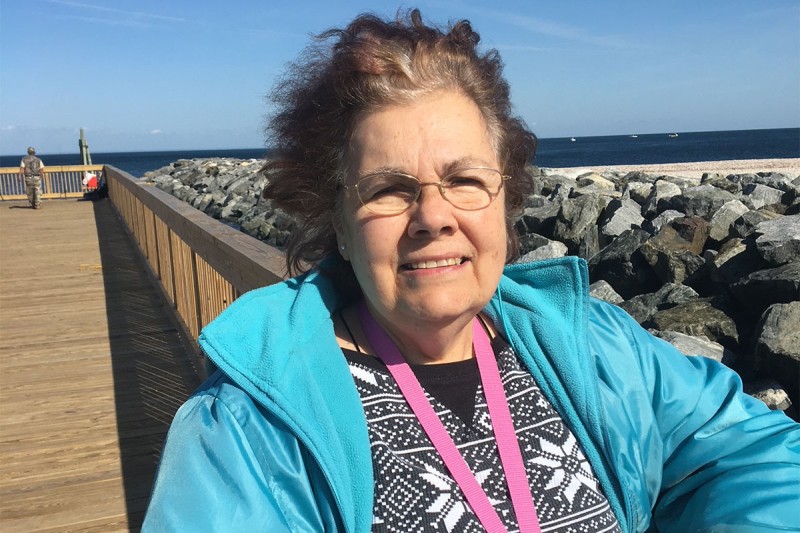
Linda Dow, above, says she wouldn't have known about cryoablation if she hadn't come to Memorial Sloan Kettering Cancer Center.
Linda Dow was running out of options.
The 79-year-old retired paralegal from Long Island was facing breast cancer for the second time. She had severe heart failure, which meant she was not a good candidate for breast cancer surgery.
But her cancer prognosis has now improved, thanks to a pain-free, minimally invasive procedure at Memorial Sloan Kettering Cancer Center (MSK) called cryoablation. It immediately destroyed her tumor, saved her breasts, and has kept her cancer free for the past six months. For some women with breast cancer who cannot have surgery, it is an innovative alternative to lumpectomy or mastectomy.
What Is Cryoablation?
Cryoablation destroys tumors by freezing cancer cells. Patients are awake during the 90-minute outpatient procedure and can go home the same day.
Mastectomy and lumpectomy are still the standards of care for breast cancer treatment, but cryoablation is promising for some patients who are not strong enough to tolerate an operation. Linda’s severe heart failure put her in that category. She transferred her care to MSK at the urging of her local oncologist.
“He said, ‘When you want the best, you go to the best, and that’s MSK,’ ” Linda recalls.
As one of the few centers in the nation to perform cryoablation therapy for breast cancer, MSK was uniquely suited to handle Linda’s care. MSK experts have been performing both simple and complex breast cryoablation procedures since 2018.
Why Choose MSK for Cryoablation?
Linda first met with MSK cardiologist Wendy Schaffer, who specializes in cancer treatment’s effect on the heart. In addition to heart failure, side effects from cancer treatment can also include high blood pressure and abnormal heart rhythms. Dr. Schaffer said that a lumpectomy would be too risky. She brought up cryoablation. Linda had known it was an option for liver cancer and some other cancers but had not heard of it being used for breast cancer treatment.
“I started to research it to understand it better,” Linda says. “If I didn’t go to MSK, I probably wouldn’t have known about this.”
She was referred to breast interventional radiologist Yolanda Bryce. Interventional radiologists diagnose and treat cancer using medical imaging to guide procedures that are not surgical. Dr. Bryce founded MSK’s cryoablation program.
“My goal is to fill the gap for patients who haven’t been able to be treated,” says Dr. Bryce.
She notes that while some private practices offer cryoablation, people who come to MSK are cared for by experts who treat cancer exclusively. Care is personalized to each patient’s unique situation.
“Cryoablation is not one-size-fits-all,” Dr. Bryce says. “We take everything on a case-by-case basis. Having done this so many times, we have the infrastructure and resources to do so.”
Cryoablation Destroys Linda’s Cancer
Dr. Bryce conferred with MSK breast surgeon Tracy-Ann Moo on Linda’s situation. A consultation with a breast surgeon is always needed before considering cryoablation. Dr. Moo agreed that cryoablation was safer for Linda than surgery.
On April 7, 2022, Dr. Bryce inserted probes into the tumor with gas that froze and destroyed it. Linda was awake and comfortable during the procedure: “I felt absolutely no discomfort or pain,” she says. “In fact, I was laughing with the doctors.”
After a short recovery period, Linda went home that very day. In July, a mammogram, ultrasound, and MRI all revealed that the tumor was completely gone.
The Future of Cryoablation
Dr. Bryce emphasizes that cryoablation is not right for everyone, and that after treatment, many patients go on to have radiation, chemotherapy, or hormonal therapy.
Recovery after cryoablation is similar to that of a breast biopsy, Dr. Bryce says. “The breast can get swollen and bruised, but it takes just a few days to recover. Patients may feel a lump in the area of treatment, but it gets smaller over time. After a procedure, I tell my patients to listen to their bodies and not exert themselves if their breast is sore.”
Dr. Bryce says there are clinical trials underway to see if cryoablation could become an option for more people with breast cancer. Researchers are also looking at ways to combine it with immunotherapy to give the cancer a one-two punch.
Picking Up Where She Left Off
Linda never let breast cancer stop her from doing what she loves. She is the president of a local cat rescue organization, a group she has been a part of for 40 years. She loves going to the beach, hiking, and whipping up the perfect grilled cheese sandwich.
“I’m as active as you can be,” she says.
She’s also on a mission to make sure more women know about the innovative procedure that saved her life.
“At least find out if cryoablation is applicable to your situation,” Linda counsels. “If it’s not, you will meet someone — a sister, a friend — who could benefit from knowing about it.”


